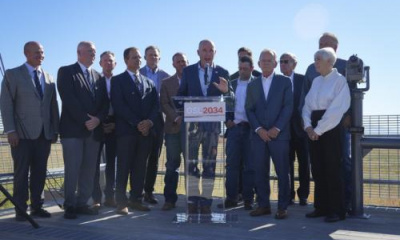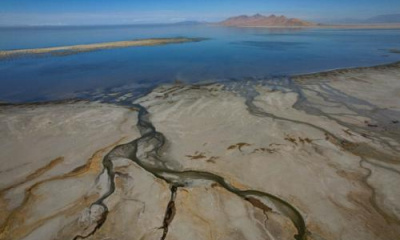Sacrificing the north arm could slow further environmental implosion, but it comes with its own consequences.
Utah Gov. Spencer Cox issued an executive order Friday that will once again raise the causeway bisecting the Great Salt Lake in an effort to slow its ecological collapse.
The move essentially creates two lakes, one dead and one on life support. The Great Salt Lake bottomed out at a record-low elevation of 4,188.5 feet on Nov. 3. Unprecedented low water levels have concentrated the lake’s salts, nearly wiping out its brine flies and threatening the health of brine shrimp, while also putting at risk the millions of migrating birds that depend on those two food sources.
“The Great Salt Lake is crucial to our environment, ecology and economy,” Cox said in a news release,” and we must do everything we can to protect it.”
The rock-filled Union Pacific railroad causeway runs from the Promontory Point peninsula to the west desert, sectioning off Gunnison Bay from the lake’s tributaries, which include the Bear, Weber and Jordan rivers.
As the causeway slowly sunk into the lakebed over time, there was virtually no fresh water reaching the north arm. Viewed from above, the north arm appears purple-pink due to halophiles that live in its hypersaline water. It has become so salty that brine flies, brine shrimp and the microbialite structures that support them have long since died off. The only birds that actively use the north arm are American white pelicans, who raise their chicks on Gunnison Island because of its seclusion.
Concerned about the lake’s ecosystem, as well as how to send rescue boats to the north arm, state regulators had Union Pacific build a new breach through the causeway in 2016.
But the lake has dramatically declined in the years since, and now state regulators are sealing up that opening once again to keep the south arm from becoming too salty. The Utah Division of Forestry, Fire and State Lands first raised it to 4,187 feet last July. Under Cox’s order, it will get filled in another five feet.
Utah has seen a remarkable amount of snowstorms this winter so far, which already helped boost the lake’s elevation by several inches. Still, it’s almost a foot lower than it was at this time last year. The south arm’s salinity sits at 17.5%, when the optimal level is 12%-16%, according to the Division. (The ocean, by comparison, is about 3.5% salt.)
“We’ve been blessed with significant snowpack so far this winter,” Cox said, “and this executive order will allow the state to move quickly to increase the lake level in the South Arm by capturing spring runoff. We don’t want to miss this opportunity to safeguard the lake.”
But an emergency briefing issued by several scientists and conservationists last month warns state leaders not to “cut our losses” and divide the lake in two. Sealing off the causeway could wipe out the pelican colony on Gunnison Island, as land bridges create access for predators and people. It could put Compass Minerals out of business, which turns the lake’s salts into fertilizer used to grow many of the world’s fruits and nuts. And it means the salt crust covering the north arm’s massive exposed lakebed will continue to erode away by the day, potentially becoming a toxic source of dust.
“Some solutions are more extreme than others,” said Bonnie Baxter, director of Westminster College’s Great Salt Lake Institute, and a co-author of the emergency briefing. “This one we see as a temporary measure to protect the ecosystem in the south arm.”
Baxter also sits on the state’s Great Salt Lake Salinity Advisory Committee, which recommended further raising the causeway berm on Jan. 23. A memo outlining the committee’s position noted salinity is so high in the south arm that it’s killing off microbialites and brine flies, which are important foundations of the lake’s food web.
“The cool thing about the berm at the breach in the causeway is that it’s relatively easy engineering to raise it and lower it,” Baxter explained. “It’s just filling it in with a backhoe.”
A committee member representing Compass Minerals attempted to insert language that highlighted the impacts the berm adjustment will have on his operation, a draft memo shows. He further called on the state to allow the company to extend its intake canals. That suggested language was nixed by the committee in a 5-2 vote.
Compass Minerals diverted 74,093 acre-feet from the Great Salt Lake and its tributaries last year, compared to 138,687 acre-feet in 2021 and nearly 160,000 acre-feet in 2020.
The Salinity Advisory Committee’s approved memo does recognize impacts to the company in sealing off the north arm, however. It urges state regulators to help the mineral extractor find ways to mitigate those repercussions.
“It does harm their process,” Baxter said.
Regarding threats to Gunnison Island, Baxter said trail cams recently captured a pair of foxes and a pair of coyotes, along with evidence the predators were trying to dig a well to fresh water.
“It was kind of brackish, life Farmington Bay. I don’t think it’s going to sustain a population of an entire pack of coyotes,” Baxter said. “I’m hoping the threat to baby birds is not as great as it would be if there were more fresh water availability.”
She further acknowledged that dust from an eroding lakebed is a concern.
“Until we get really good mapping of the concentration of heavy metals at every location,” Baxter said, “we don’t know if the north arm of the lake bed is more or less dangerous in terms of metal accumulation.”
The causeway berm can be easily adjusted to allow water to flow to the north arm again. It’s clear, however, that engineering two lakes will be the state’s go-to solution to keep the Great Salt Lake alive for the foreseeable future, while state leaders struggle to secure the water it needs.
Cox’s order calls on the Department of Natural Resources and Department of Environmental Quality to develop a berm management plan “as soon as reasonably possible.” His mandate will remain in place until that plan is final.









